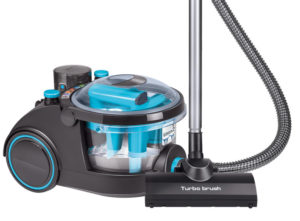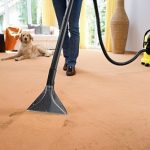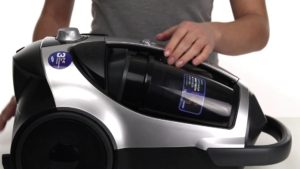 Among the huge variety of vacuum cleaners presented on the modern market of household appliances, models of world-famous brands, in particular Samsung, are still very popular. Is the choice of a well-known corporation’s product justified in this case? What are the technical indicators of the device itself hidden behind the name of the popular label? And also, what is the most competent approach to the selection of automated equipment for house cleaning? If these are the questions that have accumulated in your head, then the following article is just for you.
Among the huge variety of vacuum cleaners presented on the modern market of household appliances, models of world-famous brands, in particular Samsung, are still very popular. Is the choice of a well-known corporation’s product justified in this case? What are the technical indicators of the device itself hidden behind the name of the popular label? And also, what is the most competent approach to the selection of automated equipment for house cleaning? If these are the questions that have accumulated in your head, then the following article is just for you.
Content
About company
It is hard to imagine, but sometime in the 30s the Samsung group of companies, today known for the production of high-quality household appliances, smartphones, electronics for beauty, health and so on, was created as a rice flour production and marketing company in Korea. The founder of the then still unknown organization Lee Byung Chol, despite the limitations of private enterprise at that time, due to the belonging of the Korean colony of Japan, already 8 years after the foundation of his own business, achieved the creation of the first independent export route to China and Manchuria. Later, despite the staggering financial success in business, the rapid increase in the speed of production of goods, as well as a significant increase in the product sales areas, Samsung was forced to “curtail” its activities due to the outbreak of the Korean War at that time.
To establish a stable situation in the country after the hostilities, the new president Park Jung Hee makes a crucial decision for the corporation under consideration: to support private entrepreneurs and their concerns by issuing subsidies and consumer loans, as well as stable provision of these companies with government orders. Of course, the proactive Lee Byung Chol could not miss the opportunity and occupied a niche in the production of electronics.
Already in 1969, the corporation decided to merge with Sanyo, which served to form one of the most significant sectors of the Samsung group - Samsung Electronics. As a result of the merger of the two leading companies, black-and-white TVs are being developed and launched on the consumer market in Korea.
After a short time, the son of the “creator” comes to the leadership position of the concern, bringing his management a number of significant changes in the usual rhythm of the corporation (a new label, management system, export direction, shift of emphasis and the emergence of new sources of investment).
After a functional reconstruction, the Samsung Group went uphill. So, since 83, the active production of personal computers began, and already in 92, the first mobile device was ready for release. Since that time, the global corporation has expanded significantly and decides to engage in the development and marketing of household appliances, in particular vacuum cleaners. Having created a peculiar image of “proven quality” earlier, Samsung was not difficult to achieve success and extremely high consumer demand in a new niche. What are the features of models of popular Samsung vacuum cleaners? What makes buyers buy products of this particular brand? Now we find out.
What is a Samsung vacuum cleaner
The main distinguishing feature of the vacuum cleaners of the Korean Corporation lineup is the unique advanced design of the gadget body - MotionSync Design. The main functional part of the device is traditionally mounted on large wheels, however, unlike other brands of vacuum cleaners, Samsung devices imply independent rotation of the orbital wheels and the motor block itself.Due to the high maneuverability of the household appliance achieved by the unit with cyclone chambers and a dust collector located in front of the plastic case of the gadget, the use of such vacuum cleaners does not bring additional difficulties to the user.
Also among the unique technologies used in Samsung vacuum cleaners, one can note the system of additional nozzles used (a special tube, a brush to get rid of dust, a crevice nozzle), called Build-in-handle. The described property allows the user to reduce the time spent cleaning, eliminating the need for a lengthy process of changing nozzles to clean a specific area.
Extreme Force Brush is another design feature of the brush heads themselves, developed by the Korean “giant” for their vacuum cleaners. The user now does not have to draw the suction nozzle several times in one place in order to achieve the maximum level of cleanliness of the treated surface. Using the described technology, the manufacturer was able to achieve uniform intake of contaminants with holes located around the entire perimeter of the brush. This fact not only simplifies the cleaning process, but also ensures its high quality, in particular getting rid of large garbage.
In addition to the unique features of the nozzles and housing, it is worthwhile to pay tribute to the innovative development from Samsung - a removable dust sensor called the Dust Sensor. Focusing on the specific color of the indicator (red - dirty, green - clean), the user will be able to determine how effective the cleaning was done, while not allowing residual pollution on the treated surface.
And if, in addition to the advanced developments highlighted above, we also mention the relative silence of Samsung gadgets when cleaning, as well as their low weight, convenient cable winding system and vacuum cleaner control, it seems as if every little thing of this brand’s technology is thought out and designed for the convenience of the user. But is it? Is there really no critical design flaws? And if they are, how significant are they?
- The most common customer complaints are the increased electrostaticity of the plastic housing of Samsung vacuum cleaners. Agree, it is not very pleasant to receive electric shocks at the slightest contact with the "automated assistant" during direct cleaning. In fairness, it should be noted that this drawback is also widespread among the characteristics of models of devices of other companies, due to the inevitability of a similar phenomenon in an electric device operating under high voltage.
- Some users complain of excessive suction of nozzles to the surfaces to be cleaned. But isn't it suction power is the determining factor in buying a vacuum cleaner for cleaning the room? Devices that are poorly attracted, for example, to the carpet, are unlikely to be able to guarantee quality cleaning. Moreover, most of the top models provide for adjusting the power level on various components of the device case, which you can find out in more detail in the following review of several popular vacuum cleaner models
- Possible excesses and deformation of the hoses of household appliances of the Korean manufacturer are also noted among the frequent shortcomings that cause significant discomfort to users. Mechanical damage to the functional hose can lead to a decrease in the suction power of the vacuum cleaner, which will negatively affect the efficiency of its operation.
In deciding to buy a vacuum cleaner, Samsung is worth, in addition to the disadvantages, to evaluate their real advantages.In addition to the positive aspects that were discussed in the article above, one can mention among the advantages of the majority of Korean “automated assistants” their ease of use, a well-thought-out system of cleaning the reservoir for collecting contaminants, a wide range that varies both in cost, in design, and in direct functionality, as well as the compact size of the design of the cleaning device.
How to choose
So, you are convinced of the advisability of choosing a vacuum cleaner precisely among the proposed models by the Korean manufacturer Samsung. What characteristics should you rely on in deciding the most appropriate gadget for yourself?
- Power consumption. Most of the presented devices have a technical indicator of the level of energy consumption from 1200 W to 2500 watts. It is a mistake to rely on this characteristic in determining the effectiveness of the cleaning. In the context of the power spent, preference should be given to average performance - from 1500W to 2000W.
- The suction power just illustrates how high-quality the disposal of the room from debris and dust by the selected vacuum cleaner model will be. The ideal parameters are the numbers 300 - 500 watts.
- The blown air filtration system provided by the Korean manufacturer should optimally include a multi-stage cleaning process, in which the HEPA filter, recommended for allergy-friendly vacuum cleaners, acts as the finishing stage.
- The size of the dust bag affects not only the amount of contaminants collected for storage in the tank, but also the frequency of cleaning. The optimal dimensions in this context are considered “dimensions” from 3 to 5 liters.
- The noise level for Samsung vacuum cleaners is considered acceptable if its values are in the range of 70 - 80 dB, however, characteristics up to 95 dB are considered acceptable for comfortable perception by human ears.
- The number and types of nozzles included in the basic configuration can also be considered a fundamental criterion in choosing a specific model of Samsung vacuum cleaners. Standardly, the Korean manufacturer provides brushes for cleaning not only carpet, but also smooth surfaces, furniture, narrow crevices. This set is the optimal standard set, which can be expanded or reduced depending on the price category and the "degree of professionalism" of the selected vacuum cleaner.
Having an idea of the basic characteristics of the model range of Samsung vacuum cleaners, it is advisable to analyze the technical parameters of the top models.
The best models
SC4520
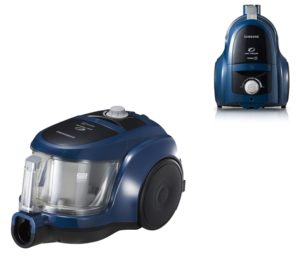
- Types of cleaning: dry
- Maximum power consumption during operation: 1600 W
- Suction power: 350 W
- Dust collector type: cyclone filter
- Dust container capacity: 1.30 L
- Noise Level: 83 dB
- Cable length: 6m
- Weight: 4.3 kg
- Additional nozzles: yes (floor / carpet)
- Built-in options: automatic winding of the power cord, foot switch on / off. on the building, vertical parking
- sufficient suction power
- compact size
- reasonable cost
- ease of operation
- “Poor” equipment
- inconvenient dust collector cleaning system
- quality of the material used
- high noise generated during operation
VC20M25
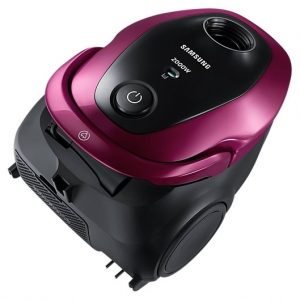
- Types of cleaning: dry
- Maximum power consumption during operation: 2000 W
- Suction power: 350 W
- Dust collector type: cyclone filter / fabric bag
- Dust container capacity: 2.50 L
- Noise Level: 83 dB
- Cable length: 6m
- Weight: 4.3 kg
- Additional nozzles: yes (floor / carpet; nozzle 2-in-1)
- Built-in options: the presence of a fine filter, the possibility of fixing the cyclone filter EZClean Cyclone Filter for large debris on the handle, a power regulator located on the body of the vacuum cleaner
- compact size
- high suction power
- the presence of two dust collectors
- build quality
- automatic shutdown of the vacuum cleaner when large debris enters the filter
- insufficient cable length
- noise level generated during operation
- high electrostaticity of the body material
VC18M21A0
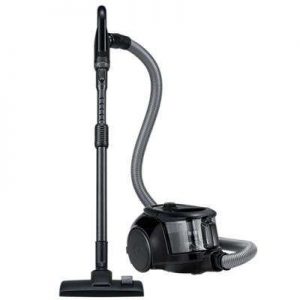
- Types of cleaning: dry
- Maximum power consumption during operation: 1800 W
- Suction Power: 380 W
- Dust collector type: cyclone filter
- Dust container capacity: 1.50 L
- Noise Level: 87dB
- Cable length: 6m
- Weight: 4.6 kg
- Additional nozzles: yes (floor / carpet; nozzle 2-in-1)
- Built-in options: the presence of a fine filter, Anti-Tangle turbine (prevents winding hair, wool and dust on the filter); Easy Grip rotary knob, power regulator located on the vacuum cleaner body
- design
- high suction power with low power consumption
- light weight
- telescopic handle
- leaks in the structure of the housing, in particular the joints
- insufficient cable length
- quick "blockage" of the turbofilter
- frequent overheating
VC18M3160
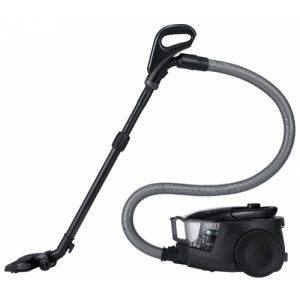
- Types of cleaning: dry
- Maximum power consumption during operation: 1800 W
- Suction Power: 380 W
- Dust collector type: cyclone filter
- Dust box capacity: 2 L
- Noise Level: 87dB
- Cable length: 6m
- Weight: 4.8 kg
- Additional nozzles: yes (floor / carpet; nozzle 2-in-1)
- Built-in options: built-in power regulator, presence of a fine filter, Anti-Tangle turbine (prevents hair, wool and dust from winding up on the filter), Easy Grip rotary handle
- light weight
- maneuverability
- acceptable noise level
- collapsible turbo brush
- good suction power
- electrostatic material of the housing
- insufficient cable length
- lack of basic nozzles, in particular for furniture
VC18M3120
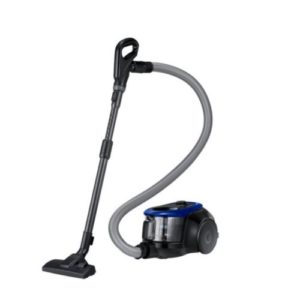
- Types of cleaning: dry
- Maximum power consumption during operation: 1800 W
- Suction Power: 380 W
- Dust collector type: cyclone filter
- Dust box capacity: 2 L
- Noise Level: 87dB
- Cable length: 6m
- Weight: 4.8 kg
- Additional nozzles: yes (floor / carpet; nozzle 2-in-1)
- Built-in options: built-in power regulator, presence of a fine filter, Anti-Tangle turbine (prevents hair, wool and dust from winding up on the filter), Easy Grip rotary handle
- acceptable suction power
- ease of use and care
- appearance
- light weight
- high noise generated during operation
- high cost of replaceable filters
- case material quality
- lack of a special place for a dust nozzle
So, based on the above information, we can make an unambiguous conclusion that Samsung vacuum cleaners, like household appliances of any other brandare not perfect. However, despite the disadvantages, the “automated home helpers” perfectly cope with their primary tasks, which is a characteristic feature of the Korean manufacturer’s equipment.

